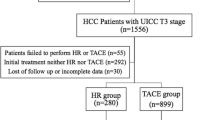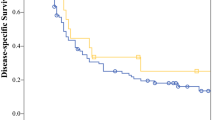Abstract
Purpose
We have previously shown that continuous intra-arterial combination chemotherapy (IACC) might be more effective for advanced hepatocellular carcinoma (aHCC) in patients with HCV-related liver cirrhosis (C-LC) or alcoholic liver cirrhosis (A-LC) than in patients with HBV-related LC (B-LC). However, it is still unknown whether IACC actually improves the prognosis of aHCC patients with liver cirrhosis (LC), because it is difficult to perform a randomized controlled trial for patients with a poor prognosis. The aim of this study was to retrospectively assess the influence of IACC on the prognosis of aHCC.
Methods
Fifty-eight adult Japanese patients who had aHCC and LC underwent repeated trans-arterial chemoembolization (TACE) without IACC between 1990 and 1997 at our hospital (group T), while 43 patients with aHCC and LC received IACC between 2000 and 2008 after undergoing several TACE sessions (group R). The Japan Integrated Staging score (JIS score) of each patient was ≥ 3 at the time of presentation, except for patients with tumor thrombi involving the first or subsequent portal vein branches or those with tumor invasion of the inferior vena cava. The same IACC regimen was repeated for as long as possible in group R.
Results
In group T, 13 patients had B-LC, 37 patients had C-LC, and 8 patients had A-LC, while the respective numbers were 14, 21, and 8 in group R. The median survival time (MST) was 248 days for patients with C-LC in group T and 708 days for those in group R, while it was 253 days for patients with A-LC in group T and 593 days for those in group R. There were significant differences of survival between the two groups. However, MST was 369 days for patients with B-LC in group T and 782 days for those in group R, without a significant difference. In group R, a complete or partial response was achieved after 4 weeks of chemotherapy in 14.3% of patients with B-LC versus 42.9% of patients with C-LC and 37.5% of patients with A-LC.
Conclusions
In LC patients with a JIS score > 3 at diagnosis, multimodal therapy with IACC after TACE prolongs the MST of C-LC or A-LC patients compared with TACE alone, although it does not improve the MST of patients with B-LC.




Similar content being viewed by others
References
Parkin DM, Bray F, Ferlay J et al (2001) Estimating the world cancer burden: Globocan 2000. Int J Cancer 94:153–156
Yu MC, Yuan J-M (2004) Environmental factors and risk for hepatocellular carcinoma. Gastroenterology 127:S72–S78
Bosch FX, Ribes J, Diaz M et al (2004) Primary liver cancer: worldwide incidence and trends. Gastroenterology 127:S5–S16
Chuang VP, Wallace S (1981) Hepatic arterial embolization in the treatment of hepatic neoplasms. Radiology 140:51–58
Yamada R, Sato M, Kawabata M et al (1983) Hepatic artery embolization in 120 patients with unresectable hepatoma. Radiology 148:397–401
Lin DY, Liaw YF, Lee TY et al (1988) Hepatic arterial embolization in patients with unresectable hepatocellular carcinoma: a randomized controlled trial. Gastroenterology 94:453–456
Ikeda K, Kumada H, Saitoh S et al (1991) Effect of repeated transcatheter arterial embolization on the survival time in patients with hepatocellular carcinoma. Cancer 68:2150–2154
Llovet JM, Real MI, Montana X et al (2002) Barcelona liver cancer group. Arterial embolization or chemoembolization versus systemic treatment in patients with unresectable hepatocellular carcinoma: a randomized controlled trial. Lancet 359:1734–1739
Lo CM, Ngan H, Tso WK et al (2002) Randomized controlled trial of transarterial lipiodol chemoembolization for unresectable hepatocellular carcinoma. Hepatology 35:1164–1171
Takayasu K, Arii S, Ikai I et al (2006) Liver cancer study group of Japan. Prospective cohort study of transarterial chemoembolization for unresectable hepatocellular carcinoma in 8,510 patients. Gastroenterology 131:461–469
Okuda K, Ohtsuki T, Obata H, Tomimatsu M, Okazaki N, Hasegawa H, Nakajima Y, Onishi K (1985) Natural history of hepatocellular carcinoma and prognosis in relation to treatment. Study of 850 patients. Cancer 56:918–928
Nagasue N, Yukaya H, Hamada T, Hirosue S, Kanashima R, Inokuchi K (1984) The natural history of hepatocellular carcinoma. A study of 100 untreated cases. Cancer 54:1461–1465
Toyoda H, Nakano S, Kumada T, Takeda I, Sugiyama K, Osada T, Kirishima S, Suga T, Takahashi M (1995) The efficacy of continuous local arterial infusion of 5-fluorouracil and cisplatin through an implanted reservoir for severe advanced hepatocellular carcinoma. Oncology 52:295–299
Murata K, Shiraki K, Kawakita T, Yamamoto N, Okano H, Nakamura M, Takahisa Sakai, Deguchi M, Ohmori S, Nakano T (2003) Low-dose chemotherapy of cisplatin and 5-fluorouracil or doxorubicin via implanted fusion port for unresectable hepatocellular carcinoma. Anticancer Res 23:1719–1722
Okuda K, Tanaka M, Shibata J, Ando E, Ogata T, Kinoshita H, Eriguchi N, Aoyagi S, Takikawa K (1999) Hepatic arterial infusion chemotherapy with continuous low dose administration of cisplatin and 5-fluorouracil for multiple recurrence of hepatocellular carcinoma after surgical treatment. Oncology Report 6:587–591
Nagai H, Sumino Y (2008) Therapeutic strategy of advanced hepatocellular carcinoma by using combined intra-arterial chemotherapy. Recent Pat Anticancer Drug Discov 3:220–226
Nagai H, Kanayama M, Higami K et al (2007) Twenty-four hour intra-arterial infusion of 5-fluorouracil, cisplatin, and leucovorin is more effective than 6-hour infusion for advanced hepatocellular carcinoma. World J Gastroenterol 13(2):280–284
Kanayama M, Nagai H, Sumino Y (2009) Influence of the etiology of liver cirrhosis on the response to combined intra-arterial chemotherapy in patients with advanced hepatocellular carcinoma. Cancer Chemother Pharmacol 64:109–114
Wilhelm SM, Carter C, Tang L et al (2004) BAY 43–9006 exhibits broad spectrum oral antitumor activity and targets the RAF/MEK/ERK pathway and receptor tyrosine kinases involved in tumor progression and angiogenesis. Cancer Res 64:7099–7109
Moreno-Aspitia A, Morton RF, Hillman DW et al (2009) Phase II trial of sorafenib in patients with metastatic breast cancer previously exposed to anthracyclines or taxanes: North Central cancer treatment group and Mayo Clinic Trial N0336. J Clin Oncol 27:11–15
Abou-Alfa GK, Schwartz L, Ricci S et al (2006) Phase II study of sorafenib in patients with advanced hepatocellular carcinoma. J Clin Oncol 24:4293–4300
Iwamiya T, Sawada S, Ohta Y (1994) Repeated arterial infusion chemotherapy for inoperable hepatocellular carcinoma using an implantable drug delivery system. Cancer Chemother Pharmacol 33:S134–S138
Wakasa K, Sakurai M, Kuroda C et al (1990) Effect of transcatheter arterial embolization on the boundary architecture of hepatocellular carcinoma. Cancer 65:913–919
Gabrilovich DI, Chen HL, Girgis KR et al (1996) Production of vascular endotherial growth factor by human tumors inhibits the functional maturation of dendritic cells. Nat Med 2:1096–1103
Ferrara N, Gerber HP, LeCounter J (2003) The biology of VEGF and its receptors. Nat Med 9:669–676
Korangy F, Ormandy LA, Bleck JS et al (2004) Spontaneous tumor-specific humoral and cellular immune response to NY-ESO-1 in hepatocellular carcinoma. Clin Cancer Res 10:4332–4341
Shevach EM (2001) Certified professionals: CD4+ CD25+ suppressor T cell. J Exp Med 193:F41–F46
Stephens LA, Mottet C, Mason D, Powrie F (2001) Human CD4 + CD25 + thymocytes and peripheral T cells have immune suppressive activity in vitro. Eur J Immunol 31:1247–1254
Jonuleit H, Schmitt E, Stassen M, Tuettenberg A, Knop J, Enk AH (2001) Identification and functional characterization of human CD4 + CD25 + T cells with regulatory properties isolated from peripheral blood. J Exp Med 193:1285–1294
Mosmann TR, Coffman RL (1989) Th1 and Th2 cells: different patterns of lymphokine secretion lead to different functional properties. Annu Rev Immunol 7:145–173
O’Garra A (1998) Cytokines induce the development of functionally heterogeneous T helper cell subsets. Immunity 8:275–283
Roitt I (ed) (1997) Essential immunology, 9th edn. Blackwell Science, Malden
Kuby J, Cameron J, Todd C, Mitchell J (2000) Immunology, 4th edn. Freeman and Company, New York
Kobayashi M, Kobayashi H, Polland RB et al (1998) A pathogenic role of Th2 cells and their cytokine products on the pulmonary metastasis of murine B16 melanoma. J Immunol 160:5869–5873
Zitvogel L, Mayordomo JI, Tjandrawan T et al (1996) Therapy of murine tumors with tumor peptide-pulsed dendritic cells: dependence on T cells, B7 costimulation, and T helper cell 1-associated cytokines. J Exp Med 183:87–97
Tsung K, Meko JB, Peplinski GR et al (1997) IL-12 induces T helper 1-directed antitumor response. J Immunol 158:3359–3365
Weiner GJ, Liu HM, Wooldridge JE et al (1997) Immunostimulatory oligodeoxynucleotides containing the CpG motif are effective as immune adjuvants in tumor antigen immunization. Proc Natl Acad Sci USA 94:10833–10837
Hu H-M, Urba WJ, Fox BA (1998) Gene-modified tumor vaccine with therapeutic potential shifts tumor-specific T cell response from Type 2 to a type 1 cytokine profile. J Immunol 161:3033
Nagai H, Miyaki D, Matsui T, Kanayama M, Higami K, Momiyama K, Ikehara T, Watanabe M, Sumino Y, Miki K (2008) Th1/Th2 balance: an important indicator of efficacy for intra-arterial chemotherapy. Cancer Chemother Pharmacol 62:959–963
Momiyama K, Nagai H, Sumino Y (2009) Changes of host immunity in relation to efficacy in liver cirrhosis patients with advanced hepatocellular carcinoma treated by intra-arterial chemotherapy. Cancer Chemother Pharmacol 64:271–277
Author information
Authors and Affiliations
Corresponding author
Rights and permissions
About this article
Cite this article
Nagai, H., Matsui, T., Kanayama, M. et al. Multimodal therapy for liver cirrhosis patients with advanced hepatocellular carcinoma. Cancer Chemother Pharmacol 68, 139–145 (2011). https://doi.org/10.1007/s00280-010-1465-z
Received:
Accepted:
Published:
Issue Date:
DOI: https://doi.org/10.1007/s00280-010-1465-z




